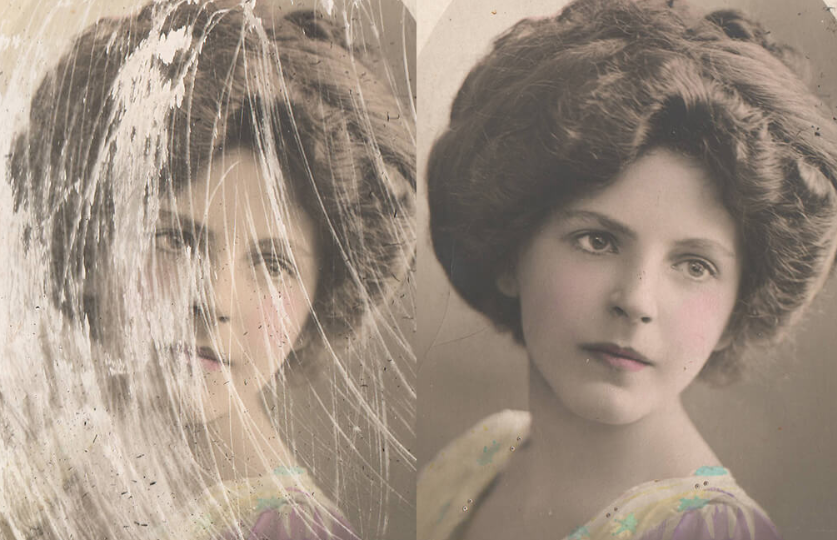Do you need to take care of an old, faded, or damaged picture? Your priceless memories might be given new life through photo restoration. Any photograph can be brought back to life with the correct equipment and expertise. In this post, we’ll go over the fundamentals of photo restoration, including how to mend scuffs and splits, wipe away dirt and dust, fix water damage, enhance color and contrast, and provide other restoration advice for your cherished photos. So, let’s get started if you’re ready to learn more about restoring your faded or damaged photos!
Basics of Photo Restoration
1. Repairing Scratches and Tears:
Repairs can involve everything from simple surface cleaning to trickier techniques like patching, cloning, and retouching. They may be carried out manually or using photo restoration software. Check to determine whether minor scuffs and tears may be repaired by first gently wiping the picture with a soft, wet cloth. If not, you might need to carefully brush out any remaining marks using a pencil eraser. A digital restoration tool like Adobe Photoshop’s “Spot Healing Brush” or “Clone Stamp Tool” may be required to manually fix more extensive regions of damage.
2. Removing Dust and Dirt Particles from Photos:
To get rid of dust, dirt particles, and other blemishes on photos, you can use a blower brush or compressed air duster. Be sure to work lightly with the brush so you don’t scratch the photograph during the process. You can also try using special photo cleaning solutions or wipes that are designed specifically for removing dust and dirt from photographs.
3. Fixing Water Damage:
For photographs that have been water damaged, you should first try gently dabbing them with a dry cloth until all the excess moisture has been removed from the surface of the image. Next, use an absorbent material such as a paper towel or tissue paper to pull away any remaining liquid on the surface of the photograph without smearing it further into any existing damage. Finally, use cotton swabs dipped in distilled water to clean up any muddy areas in your photograph that might be caused by mineral deposits from hard water sources such as tap water sources in older homes or buildings.
4. Improving Coloration and Contrast Levels in Photos:
To restore faded colors in photos, start by adjusting exposure levels to bring back some of the details lost due to fading over time. Once exposure settings have been adjusted correctly you can begin adding color enhancement tools such as vibrance/saturation sliders or hue/saturation adjustment layers within your editing software of choice (Adobe Lightroom/Photoshop etc). Additionally, adding contrast adjustments will help bring out fine details even further in your images while still preserving natural tones & color saturation throughout your photo restoration process.
5. Making Digital Enhancements:
After repairing scratches & tears and restoring colors & contrast levels within an image it’s important not to forget about making digital enhancements which are key for creating those finishing touches needed for professional-looking results when restoring old photographs! This could include anything from removing redeye effects/blemishes found on people’s faces down to performing sharpening filters which help improve overall clarity within your restored images before they’re finalized & ready for printing!
Tips for Restoring Faded or Damaged Photographs
1. Use professional photo restoration software for the best results. Professional photo restoration software makes it easy to repair scratches, tears, and other damage on photographs while preserving the image’s original colors and tones. It also offers additional tools such as color correction, sharpening, dust removal, and more.
2. Be mindful of the tools you use when repairing scratches or tears in photos. For example, when using a pencil eraser to remove scuffs, be sure not to rub too hard and cause further damage to the photograph. Additionally, avoid using solvents or any other chemical solutions unless they are specifically designed for cleaning photographs as these can cause irreversible damage over time.
3. Scan your photograph before starting your restoration process so that you have an electronic copy of it in case something happens during the process. This will ensure that you can always go back to the original image if needed without risking further damage to the physical photograph itself!
4. Make incremental changes throughout your photo restoration process rather than making big changes all at once so that it’s easier for you to keep track of what edits you’ve made and how they are affecting your image overall. This way if something doesn’t look right then it won’t be too hard for you to undo whatever changes were made (or at least adjust them) without having to start all over again from scratch!
5. Finally, it is important to remember that restoring old photographs takes patience and practice! Don’t expect perfection right away – take the time to learn more about digital photography techniques as well as best practices when performing photo restorations so that you can get better and faster results with each attempt!
Using AI and expert services for photo restoration
A. AI-Driven photo restoration Services
With improvements in artificial intelligence (AI), there is AI-driven image restoration gear to be had to assist repair vintage, damaged snapshots. This gear can examine your snapshots, perceive areas of damage, and automatically apply repairs to the usage of superior algorithms. When searching for “damaged photo restoration near me,” you could come across online offerings that leverage the AI era to provide quick and green photo recovery solutions.
B. Finding the right professional service to your needs
There are numerous photograph restoration services available, both online and in-store, making it vital to find the one that suits your desires pleasantly. Consider factors together with the form of harm your pictures have, the extent of information required, and your finances whilst choosing a service. Online photo restorer services, like MemoryCherish photograph restoration, offer comfort and ease get entry.
Final Thoughts
Restoring old and damaged photos can be a daunting task but with the right tools, knowledge, and patience anyone can do it. With this article as your guide, you’ll have all the tips, tricks, and techniques to make any photograph look new again! Photo restoration is an amazing way to bring back memories from days gone by so don’t let your faded or damaged photographs stay forgotten in time – act today for long-lasting results tomorrow! So, grab your supplies and get ready to restore those precious images – happy restoration!








